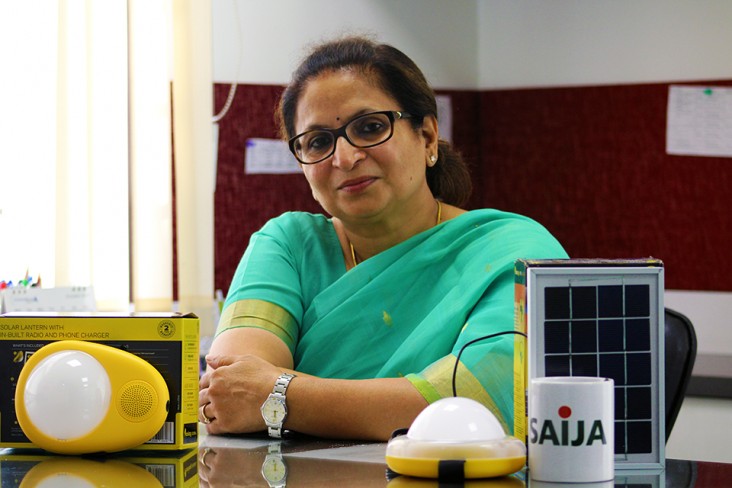India
- History
- Our Work
- Transforming Development Through Innovation & Partnership
- U.S.-India Triangular Cooperation
- Partnership for Energy Access and Security
- Partnership for Sustainable Forests in India
- Partnerships for Health
- Partnership for Education
- Partnership for Water Sanitation and Hygiene (WASH)
- Partnership for Food Security
- Partnership for Gender Equality
- Investing in Afghanistan
- Foreign Assistance Data
- Newsroom
- Newsletters and Fact Sheets
- Speeches
- Resources For Implementing Partners (RFIP)
- Careers
- Partnership Opportunities
- Success Stories
Speeches Shim

A woman entrepreneur makes clean energy solutions affordable and accessible in rural India
To make a significant impact on people’s lives, we wanted to provide comprehensive assistance, and energy, especially renewable energy, is one such area. It’s not only cleaner but it also positively impacts health, education, economy, environment and livelihoods of those whom it reaches.
Entrepreneur Rashmi Sinha is much like the crisp, green-colored cotton saree that she is wearing. Calm and an eloquent speaker, Sinha is co-founder and director of Saija—India’s first microfinance institution headquartered in the city of Patna in one of India’s poorest states Bihar.
In Bihar where Saija operates, while most of the population is connected to the grid, erratic electricity supply ensures that people depend on sunlight during the day and kerosene lamps at night to power their lives. As a result, Saija began lending to poor and small entrepreneurs who could not afford to buy lighting solutions and were refused support from traditional financial institutions.
But there’s a golden lining to this woman entrepreneur that’s hard to miss: Sinha’s business choices are not driven by profits but people.
An economics and business graduate from two of India’s most prestigious colleges, Sinha worked in various high-profile roles and was part of the core team responsible for turning around the fate of India’s largest public steel company. “But deep down, I always felt I wanted to work for the poor and vulnerable,” says Sinha.
So after 18 years of working in the corporate sector, Sinha and her husband gave up their flying careers to settle down in the dark and dusty bylanes of Patna, and established Saija. “We decided to name it after the renowned holy saints – Sai Baba and Khwaja Moinuddin Chisti – who dedicated their entire life working for the poor. Their selfless work became our motivation and inspiration,” explains Sinha.
To aid the couple in their life mission, in 2015, USAID selected Saija to develop and deploy an innovative solar lighting energy lending program under the U.S.-India bilateral initiative called the “Partnership to Advance Clean Energy – Deployment Technical Assistance” (PACE-D TA) program. Saija and six other selected microfinance institutions provided microloans of 9-12 months to poor families and small and medium enterprises to facilitate access to energy and reduce the use of traditional harmful fuels.
“To make a significant impact on these people’s lives, we wanted to provide them with a comprehensive assistance, and energy, especially renewable energy, is one such area. It’s not only cleaner but it also positively impacts health, education, economy, environment and livelihoods of those whom it reaches,” says the 57-year-old entrepreneur.
Unfortunately for Sinha, her previous venture into clean energy lending left a dent in the company’s balance sheets. “The solutions were of poor quality due to which people defaulted on their loans. No one wanted to pay money for a bad product,” she says.
But insistent on the idea of providing energy to thousands of poor and powerless households, Sinha once again decided to enroll Saija into USAID’s energy lending program. “My husband quoted the losses to keep me away but I bulldozed him into it against his wishes,” she laughs.
Sinha deeply involved herself into developing the lending model under the USAID program. “She regularly interacted with the USAID team, and assisted during the field visits. She helped develop incentive and reward schemes, case studies and closely monitored results from our test pilots,” says Anurag Mishra, Clean Energy Specialist at USAID/India and Program Manager of the PACE-D TA.
“We developed a hybrid Loan Officer and Energy Officer business model where the latter, with their deeper knowledge of energy products, ensured staff training, logistics and after-sales service; and the former facilitated the sales based on the close rapport with the community, thus creating a win-win model for everyone,” explains Sinha, adding, “of course, USAID helped us in selecting the right solar products and in training our staff to overcome challenges of trust, attracting clients, and assuring loan repayment.”
For each solar product which includes options for lighting, mobile charging and household appliances like table fans, the program created tailor-made loan models. “The products would cost anywhere between Rs. 2,000 and Rs. 5,000 and could be easily repaid by families in small, affordable installments,” adds Mishra.
Together with affordable pricing and excellent after-sales services, Saija and PACE-D TA’s three-year partnership has to date provided loans of up to $2.6 million to help over 76,000 families access clean energy. “Interestingly, 100 percent of all our borrowers and consumers have been women,” says Sinha, as Mishra adds, “in fact, 57 percent of all trainees across the seven microfinance institutions have also been women.”
The PACE-D TA lending program has today reached 1.6 million people in nine Indian states. “When I go out into the field, I’m amazed how a single source of lighting, like a solar lamp, changes and reshapes a family, a community and entire villages. I have seen kids getting healthy and wanting to read and learn. And women who are confidently running their shops and businesses. I’m so proud I have been able to witness and be a part of this change. Not a single day goes by when I do not thank God for giving me this opportunity,” smiles Sinha.

Comment
Make a general inquiry or suggest an improvement.